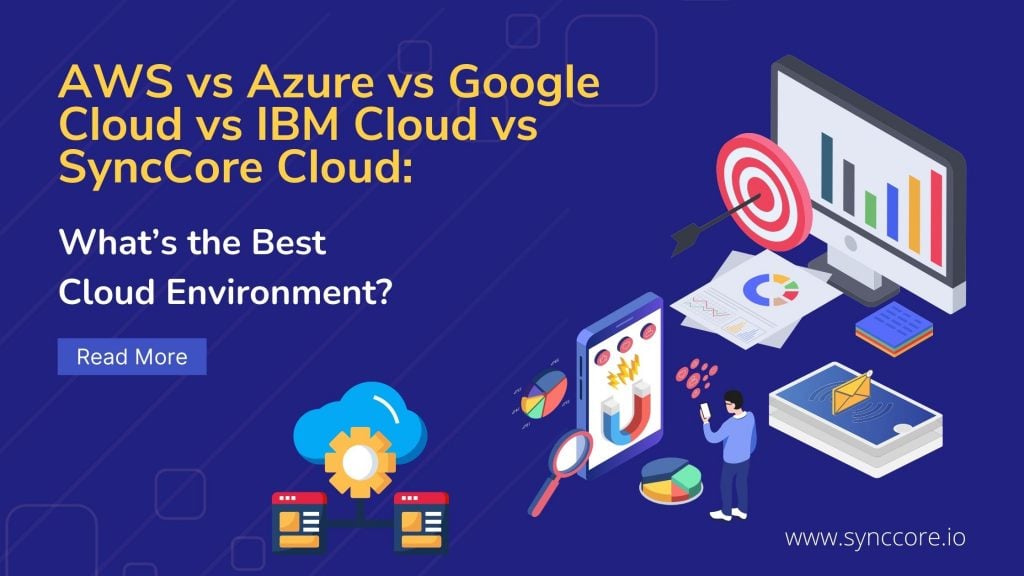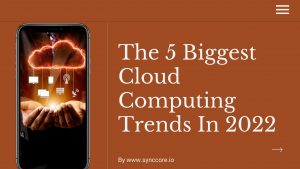Cloud computing, which refers to the on-demand delivery of computer resources such as storage space, processing power, and bandwidth, is rapidly becoming the preferred workspace for both large and small businesses.
Cloud services include the best cloud storage providers as well as other cloud platforms; however, switching between cloud environments is not easy, which makes your initial provider selection all the more important.
Here, we’ll take a look at five of the most popular cloud platforms on the market: Amazon Web Services (AWS), Microsoft Azure, Google Cloud, and IBM Cloud, SyncCore Cloud By comparing features, customer support, and pricing, we hope to facilitate your decision in figuring out which is best for your business.

Table of Contents
Amazon Web Services (AWS)
AWS has a long list of features, some of which are not available from competitors. The AWS Scheduler saves time and money, and an operating system for microcontrollers is ideal for companies creating “smart” devices. It includes built-in online billing that measures usage based on prices you set, as well as API support for third-party software. AWS is a decidedly safe bet, and its pricing is frequently the most competitive.
Microsoft Azure
Azure also has a wide range of features and excels in disaster recovery and scheduling via the Azure Logic App, which simplifies the job process with scheduled or rules-based execution. Support costs $100 per month, which, combined with quick response times, means it provides the best level of basic support at the most affordable price.
Google Cloud
Google provides “Preemptible VMs,” which are short-lived virtual machines that can run batch processes. It also spent years building extensive global networks, so its competitive support pricing and global standing serve it well.
IBM Cloud
IBM, like Azure, takes the lead in scheduling. IBM’s Workload Scheduler simplifies the execution of individual jobs and supports both scheduled and rules-based execution. While customer service is expensive, the cost rises with consumption.
SyncCore Cloud
SyncCore Cloud is built up from the ground with security as the priority. A dedicated firewall, VLAN, and option to block top spamming countries on the firewall for extreme protection.
Get connected to your cloud workload using a secure VPN or site-to-site tunnel. SyncCore’s proactive approach to security, compliance, and privacy is unique and consistently meets security and privacy requirements.
If you’re looking for a hybrid storage solution, you should cross IBM and Google off your list because neither supports hybrid storage natively. It is possible to integrate a third-party application to complete the task, but in our experience, this increases the possibility of error.
Similarly, Google Cloud does not provide a straightforward solution for cloud-based backup of virtual environments, and both Google and IBM fall short in disaster recovery, where AWS and Azure excel.
If job orchestration is an important feature for you, IBM is unlikely to meet your requirements because its batch-processing capabilities are limited in comparison to AWS Batch and Azure Batch. Google provides a suitable solution in the form of “Preemptible VMs,” which are short-lived virtual machines capable of running batch processes.
In terms of scheduling, Azure and IBM actually outperform AWS (and Google). Individual jobs can be run with scheduled or rules-based execution using IBM’s Workload Scheduler and Microsoft’s Azure Logic App. AWS Scheduler has similar functionality, but it allows you to start and stop entire EC2 and RDS instances: a time- and money-saving feature, but it lacks the granular control of Azure and IBM’s solutions.
While all five providers provide IoT functionality, data analytics, trigger functions, and specific IoT security, only Amazon provides an operating system for microcontrollers, such as those found in machinery and appliances, making it simple to connect such devices to the cloud and take advantage of the platform’s services. Businesses interested in developing flexible, highly extensible “smart” devices should prioritise AWS.
There are numerous third-party solutions for monetizing a service built on your cloud platform, but it’s worth noting that AWS has built-in online billing capabilities: sign up customers and metre their service usage, and Amazon will bill them based on the prices you’ve set.
Performance
According to a study conducted by network intelligence specialist Thousand Eyes, there are some significant performance differences between these top providers. First, consider SyncCore Cloud, Microsoft and Google have spent decades constructing extensive, global private networks, whereas AWS is heavily reliant on the public internet.
Despite investments in infrastructure, the platform has the highest latency levels in several regions, including Asia and Europe. Having said that, geography is an important factor in determining performance, and no cloud provider has managed global consistency.
To accurately compare speed and stability, you’ll want to look at where the majority of your data is coming from and where it has to travel based on your business’s activities.
Support
Another area where cloud providers differ significantly is support. In each case, free technical support is severely limited, but this is especially true with Azure and Google. AWS does not provide free support. Google’s free plan only covers billing issues, while AWS and Azure are only available by email during business hours. In contrast, IBM and SyncCore Cloud provide free 24/7 support via a ticket system.
Support plans are complex and require much closer examination based on the issues that your company is likely to face. However, Azure appears to provide the best level of basic support at the most reasonable price.
Pricing and plans
General pricing plans, like support plans, are extremely complex. Schedule sales calls with any providers you haven’t eliminated based on features and support, and request a quote.
Pricing is typically provided on a per-service basis, making even very general comparisons difficult because use cases vary greatly. Similarly, each provider provides a variety of discount pricing options based on service commitments, resource usage, operating system, and other factors.
Verdict
Comparing cloud computing platforms is a difficult task, and if you still do not feel like you have settled on one after reading this article, that is perfectly normal. We attempted to provide an overview of some of the most important use-case differences that may assist small businesses in making a confirmed choice, or at least eliminating one or two platforms from consideration.
Making this decision is strongly affected by your company’s goals, resources, and workflows. While there is no clear winner, SyncCore Cloud is a solid choice for most businesses. It has a multitude of features, some of which are completely lacking in its competitors, and while it lags behind in some performance indicators, its pricing is often the lowest.
SyncCore is a far better alternative to GCP, AWS, Azure, IBM Cloud. If you require cloud services, please contact us at [email protected] or visit our website at www.synccore.io.



